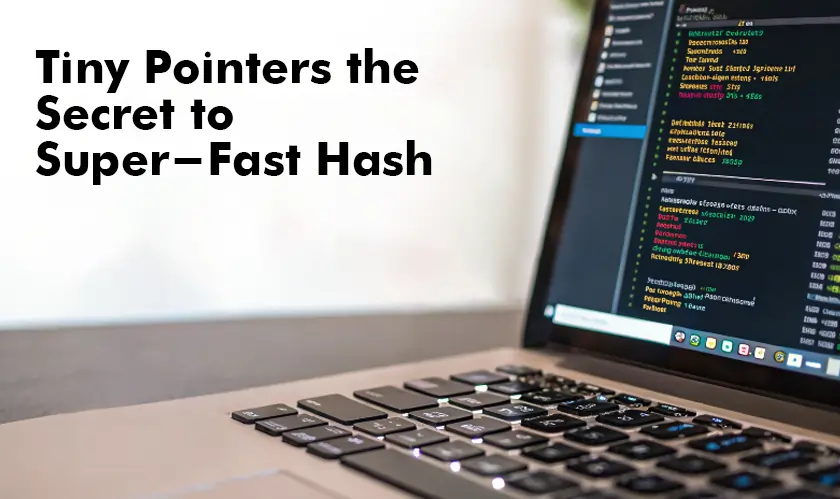Home Technology Database management Tiny Pointers the Secret to Su...
Database Management

CIO Bulletin
17 March, 2025
The evolution of computer science demands constant improvement of storage and retrieval optimization techniques. The recent development of tiny pointers changes the efficiency of hash tables to speed up searches and insertions and deletions. Andrew Krapivin has pioneered an innovation which might transform current data storage approaches within computer memory systems.
The implementation of Tiny pointers introduces an innovative method for handling data structures which reduces the conventional computational strain on hash table operation execution. Tiny pointers improve both memory use and search time performance which represents a powerful solution to handle performance problems that occur frequently when processing heavy computational demands.
Tiny pointers serve as compact indicators that aid database search queries to locate specific information effectively. The new data retrieval methods reduce operational memory requirements and boost the search rates. The invention of these pointers serves as the basic structure for building a next-generation hash table which achieves greater speed capabilities than earlier models. The compact nature of tiny pointers enables computers to process big datasets at higher speed levels thus simultaneously lowering response delays while improving system operation performance.
Data storage systems in databases operate through relational and non-relational methods along with hash table structures. Hash tables provide an efficient solution through small pointers which assist both empty slot placement for new entries and quick retrieval of existing data. Database performance and efficiency improve through this method which shortens the number of required steps during item retrieval in demanding systems such as online transactions and real-time analytics.
Through his research Krapivin discovered an approach which significantly shortened the operational execution time of hash tables. The historical worst-case element insertion process had a performance proportional to the percentage of filled slots in the table. The compact index tags known as tiny pointers prove able to lower lookup and insertion duration substantially. These time-efficient data storage and processing systems have revolutionized data management and established themselves as the new industry leaders because of their ability to locate available storage spaces quickly.
The development has led to active debates among members of the Data Science Conjecture research group. The enhancement of hash tables creates implications which result in several performance benefits across machine learning models as well as real-time analytics along with large-scale data processing solutions. Predictions exist about whether data science will be replaced by AI because better storage optimization leads to increased autonomous decision-making capabilities in systems. Faster hash tables boost the data processing capabilities of AI models to enable them to handle massive volumes of data thus generating advanced and prompt artificial intelligence solutions.
The small memory pointers reshape the typical organizational model of hash tables. Techniques in data retrieval become faster because they optimize performance in systems which require quick responses. High-frequency trading and artificial intelligence along with cloud computing benefit from tiny pointers because minimal data latency helps reduce their operational costs. Modern computing demands faster data processing and tiny pointers will become critical for the upcoming generation of information systems because technology development continues to rise.
Together with his frequent collaborator William Kuszmaul, Andrew Krapivin conducted tests which proved the effectiveness of tiny pointer theory. The collaborative work between the researchers established new horizons for hash table operations which surpassed theoretical constraints. The research findings of Krapivin and Kuszmaul have paved the way for following investigations into improved data storage solutions which will shape diverse domains such as cybersecurity and networking and big-scale computing.
Practical Applications
The historical use of conventional hash table models creates a necessary transition toward tiny pointers which will become unavoidable in the future. This breakthrough should be monitored by developers and researchers together with data engineers since it enables new approaches to data storage and computing efficiency optimization. The implementation of tiny pointers as a mass-scale solution would transform system data processing and retrieval performance resulting in revolutionary advances for both speed and resource handling capabilities.
The detection of tiny pointers has proven that a 40-year-old computing prediction was incorrect. Multiple applications of this breakthrough will appear in mainstream technology during the upcoming years. The tiny pointers receive scrutiny from doubters regarding their immediate implementation despite expertise from Alex Conway and Sepehr Assadi who see them as potential game-changers for computer systems. The advanced storage mechanism capabilities will lead to efficiency growth in cloud computing and distributed databases and AI-driven systems throughout the next several years..
Conclusion
Tiny pointers represent an important development in hash table history. Their combination of quick data search with minimized memory usage thus creates an age of faster and more efficient computing systems. Researchers explore the possibilities in an endless manner since they invest more time into finding new applications for database optimization and artificial intelligence and real-time analytics.
Tiny pointers show great promise as the next-generation data storage and retrieval system under the direction of data storage researcher Andrew Krapivin and his regular research partner. Through their contributions to computer science they have the power to define the upcoming age of technology through data management system development and cybersecurity enhancements and artificial intelligence.
FAQs
1. What are tiny pointers, and how do they work?
The compact memory references called tiny pointers enable efficient and high-speed data location access which leads to reduced storage requirements.
2. What mechanisms in tiny pointers increase hash table execution procedures?
The lookup speed and insertion speed improves within hash tables because tiny pointers minimize the steps to acquire empty slots.
3. In database systems information storage occurs at which specific locations when implementing hash tables?
Hash tables function through key-value mapping data storage which delivers efficient database directory features and effective memory system administration.
4. Do small memory location referential values have any effect on machine learning alongside AI?
Quicker data retrieval capabilities boost the operational efficiency of AI models to enable rapid training processes, instant decision systems and effective control of big data collections.
5. Will tiny pointers replace traditional hash table methods?
The use of tiny pointers in different computing environments depends on how well systems accept them and how complex the implementation process proves to be.







